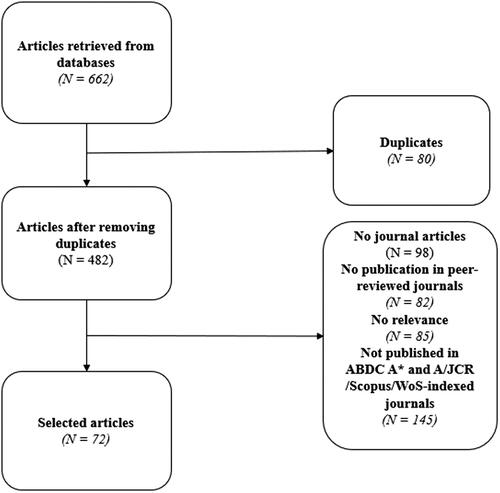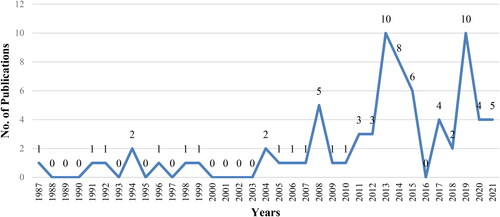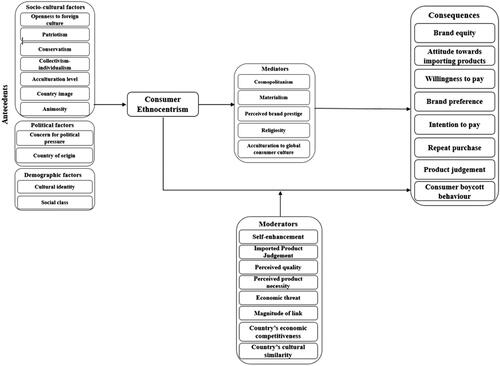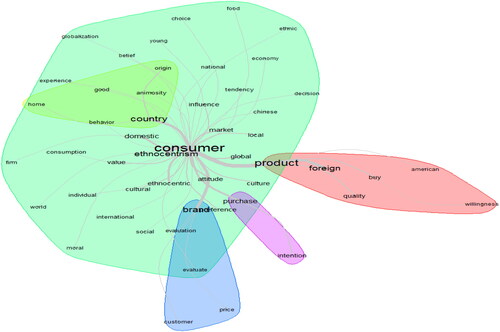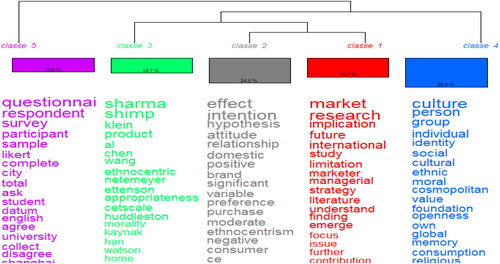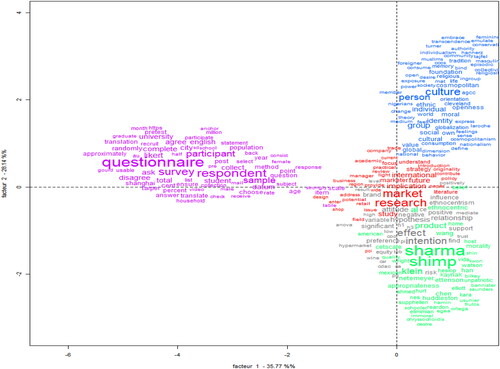Abstract
This systematic literature review aims to synthesize the academic research on consumer ethnocentrism comprehensively. The study systematically examines the development of consumer ethnocentrism research over time, including publication years, publication outlets, authorship, countries, methods, and theories utilized. Based on the synthesized literature, this review proposes a conceptual framework that integrates consumer ethnocentrism’s reported antecedents, mediators, and consequences. Furthermore, a lexicometric analysis is conducted to identify key themes and trends in consumer ethnocentrism research. The review also identifies under-researched areas in consumer ethnocentrism and provides directions for advancing future research, emphasizing theory development, contextual considerations, characteristics, and methodologies. Overall, this systematic review significantly contributes to the existing body of consumer ethnocentrism literature and offers valuable practical insights for destination marketers and policymakers aiming to implement consumer ethnocentrism strategies effectively.
REVIEWING EDITOR:
1. Introduction
Globalization has increased market competition, encompassing domestic and international products (Netemeyer et al., Citation1991). As a result, consumers now enjoy greater freedom in selecting from a wide variety of foreign brands, owing to their increased availability (Kashi, Citation2013). Consequently, scholars and practitioners in the market face the pressing need for a more profound comprehension of the factors that shape customer attitudes toward foreign products (Klein et al., Citation1998).
One concept that illuminates these attitudes is ethnocentrism, initially introduced by Sumner (Citation1907), a sociologist from Yale University. Ethnocentrism denotes an individual’s predisposition to favor and exhibit bias towards those who share similar cultural backgrounds while displaying aversion towards those who are culturally dissimilar. This notion was later adopted within consumer behavior, where its fundamental premise aligned with the imported construct (González-Cabrera & Trelles-Arteaga, Citation2021). Shimp and Sharma (Citation1987) defined ethnocentrism as a belief system involving moral judgments about whether or not to purchase foreign-made products. Shankarmahesh (Citation2006) illustrated ethnocentrism as consumers’ tendency to avoid foreign-made products, regardless of their quality or price.
In the modern consumer landscape, individuals are presented with a plethora of choices when it comes to selecting products and services. Here, consumer ethnocentrism is crucial, as the country of origin determines the decision-making process. Consumers with high ethnocentric tendencies prefer domestically produced products, sometimes even experiencing guilt when forced to opt for foreign-made alternatives. This desire to choose domestically manufactured products is profoundly ingrained and manifests as a general inclination across various purchase situations. Consumers are also mindful of their choices’ significant impact on employment opportunities and the national economy (Supphellen & Grønhaug, Citation2003; Yagci, Citation2001).
A systematic literature review on consumer ethnocentrism is crucial for multiple reasons. Firstly, it sheds light on the significant influence of consumer ethnocentrism on behavior and purchase decisions, allowing businesses to tailor marketing strategies and product offerings accordingly. Secondly, it enables researchers to synthesize existing knowledge, identify patterns, and contribute to advancing the field. Additionally, a systematic review provides a comprehensive overview, helps address inconsistencies, and guides future research directions. Lastly, it informs policymakers and trade organizations, aiding policy decisions and promoting domestic industries, exports, and international trade agreements. Overall, such a review enhances understanding of consumer behavior, identifies research gaps, and informs practical implications for global marketing and trade. The present article is an attempt to answer the following research questions:
RQ1: How has research on consumer ethnocentrism evolved since its inception?
RQ2: What theories and empirical methods have been utilized in consumer ethnocentrism research?
RQ3: What are the critical gaps in consumer ethnocentrism research?
2. Methodology
2.1. Structure of review
Systematic literature reviews are commonly conducted in both non-business and business contexts, with domain-based reviews being the most prevalent approach (Kipnis et al., Citation2012; Paul & Criado, Citation2020). Domain-based reviews encompass various types, including hybrid-narrative reviews, bibliometric reviews, meta-analytical reviews, framework-based reviews, and framework development reviews (Barari et al., Citation2020; Kumar et al., Citation2020; Mishra et al., Citation2020; Nguyen et al., Citation2008; Oraee et al., Citation2017; Paul & Rosado-Serrano, Citation2019; Paul & Benito, Citation2017; Randhawa et al., Citation2016; Verma & Gustafsson, Citation2020; Xu et al., Citation2018). These structured reviews aid in synthesizing literature on variables, theories, and research methods (Rosado-Serrano et al., Citation2018).
Ganeshkumar and Gopalakrishnan (Citation2013, p. 10) emphasize that systematic literature reviews adhere to rigorous scientific design principles, following explicit, pre-specified, and reproducible methods. Jebarajakirthy et al. (Citation2021, p. 2) highlight the significance of structured, systematic reviews in consistently synthesizing research findings. Such reviews are considered essential tools for advancing knowledge in a specific field and offering insights for future research (Ganeshkumar & Gopalakrishnan, Citation2013).
The TCCM (theories, contexts, characteristics & methods) framework was employed in this study to ensure clarity and comprehensive coverage of the systematic literature review. Established frameworks such as the 5W1H and ADO have been widely used in structured literature reviews (Lim, Citation2020; Paul & Benito, Citation2017). Utilizing such frameworks allows for a structured approach that addresses critical aspects of the research, providing a clear understanding of the theories, contexts, characteristics, and methods relevant to the topic. Jebarajakirthy et al. (Citation2021, p. 3) emphasize the significance of employing these frameworks to achieve high clarity and coverage in literature reviews. Following this recommendation, the TCCM framework was selected as the organizing framework for our systematic literature review, ensuring a comprehensive and systematic examination of the research on consumer ethnocentrism.
2.2. Organising framework
Researchers commonly use a framework to provide the synthesis of the literature in systematic literature reviews (Jebarajakirthy et al., Citation2021; Lim et al., Citation2021; Srivastava et al., Citation2020). The mechanics of a systematic literature review need to be organized about theories, features, settings, and methodologies (Paul & Criado, Citation2020); as a result, this research deploys Paul and Rosado-Serrano (Citation2019) TCCM framework to synthesize the literature in consumer ethnocentrism research and recommend avenues for future research. The TCCM framework developed for this investigation is depicted in . Lim et al. (Citation2021), along with Paul and Rosado-Serrano (Citation2019), inspired the development of this framework.
Figure 1. TCCM framework application.
Adopted from Jebarajakirthy et al. (Citation2021), Lim et al. (Citation2021) and Paul and Rosado-Serrano (Citation2019).
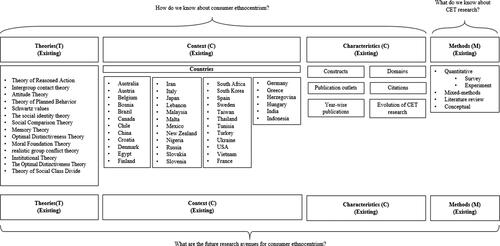
2.3. Topic selection
The method Paul and Criado (Citation2020) suggested for a systematic literature review was followed to analyze the existing literature on consumer ethnocentrism. Paul and Criado (Citation2020) have posited that good reviews are impactful, and that happens for the reasons when the authors have not picked up a recurrent topic, do not have several other studies published with the same frame in the same duration for the theme, or the topic is too non-contemporary. The authors must check for novelty on databases such as Scopus/WoS/Google Scholar/EBSCOHOST.
Topic selection has been greatly emphasized to develop an impactful literature review (Jebarajakirthy et al., Citation2021; Paul & Criado, Citation2020). Jebarajakirthy et al. (Citation2021) mentioned that a literature review should not be too current in publication. Hence, the authors explored and found three literature reviews on consumer ethnocentrism research (refer to ).
Table 1. Existing literature reviews in the consumer ethnocentrism research.
As suggested by Jebarajakirthy et al. (Citation2021), for positioning the present review, a content analysis was executed of a study of the published literature. indicates that three out of five literature reviews posted were not directly associated with Consumer ethnocentrism (Battisti et al., Citation2021). The focus of these articles was broad, and consumer ethnocentrism was studied as a slice. These reviews did not provide a proper review of consumer ethnocentrism.
The remaining two published literature reviews focused on consumer ethnocentrism research (Balabanis & Siamagka, Citation2021; Shankarmahesh, Citation2006). The scope of these reviews was somewhat limited. For example, Shankarmahesh (Citation2006) developed an integrated review of 45 publications and presented consumer ethnocentrism research antecedents, outcomes, mediators, and moderators. Balabanis and Siamagka (Citation2021) performed a meta-analysis of 240 documents analyzing journal articles, research reports, newspaper articles, and conference papers. The current article is unique as an integrated review was performed (Shankarmahesh, Citation2006), whereas Balabanis and Siamagka (Citation2021) used meta-analysis as the review method. A meta-analysis combines and synthesizes quantitative study findings (Paul & Barari, Citation2022).
Even though the reviews offered a synthesis of research on consumer ethnocentrism, the scope was constrained. For example, Shankarmahesh (Citation2006) examined the maximum peer-reviewed articles for integrated literature review. But, the published review articles did not synthesize characteristics, methods, contexts, and theories, which is considered essential for an enriched systematic literature review (Jebarajakirthy et al., Citation2021; Paul & Criado, Citation2020; Paul & Rosado-Serrano, Citation2019). The published articles only answered, “what do we know about consumer ethnocentrism?”. The reviews did not answer “how we identify consumer ethnocentrism?” Thus, there is a window of opportunity for a systematic literature review.
2.4. Search strategy
After carefully selecting relevant keywords, an extensive exploration of published articles was conducted by identifying a range of online databases. Previous systematic literature review (SLR) papers have utilized three to eight databases to conduct their article search, as evidenced by Jebarajakirthy et al. (Citation2021) and Steven et al. (Citation2011). Building upon this precedent, we strategically chose to include eight databases for the current SLR: Google Scholar, ELSEVIER, Taylor and Francis, EBSCO, ProQuest, Emerald, JSTOR, and ScienceDirect. These databases were deliberately selected due to their reliability and frequent utilization in recent SLR papers. By incorporating these established databases, we sought to minimize the likelihood of overlooking pertinent articles, ensuring a comprehensive and rigorous review (Paul & Criado, Citation2020). Additionally, after adopting Google Scholar as a database, the chances of omitting an article have been reduced (Gehanno et al., Citation2013).
The authors used ethnocentrism and ethnocentric tendencies as transposable terms (Balabanis et al., Citation2001; Shimp & Sharma, Citation1987). Consequently, Consumer ethnocentrism, Ethnocentrism, Consumer behavior, consumer attitude, Country of origin International marketing foreign products were the keywords to search relevant articles published from 1987 to 2022 on databases. Those articles that mentioned keywords in the title, list of keywords, or abstract were considered for the systematic literature review. Out of the downloaded articles, many articles were excluded. The following section expands on the inclusion and exclusion criteria.
2.5. Inclusion and exclusion criteria
A total of 662 articles were downloaded from carefully chosen databases using identified keywords. In the next stage, 80 duplicate articles were deleted. After the deletion of duplicate articles, 482 articles remained. These articles were gauged for their suitability. Out of 406 articles, 98 were removed as they were not journal articles. A total of 82 articles were removed as they were not published in peer-reviewed journals. A total of 85 articles were removed as they were not found to be relevant to the theme (consumer ethnocentrism). Moreover, to uphold the review’s standard of excellence, only articles that met specific criteria were deemed eligible for inclusion. Specifically, articles were required to be published in journals classified as either A* or A according to the esteemed Australian Business Deans Council (ABDC) Journal Quality List. This meticulous selection process, as Paul and Criado (Citation2020) outlined, ensured that the chosen articles maintained high credibility and relevance. Thus, 145 more articles were removed from the database created by the authors. The selected studies included those completed in 43 countries. presents the process followed for inclusion and exclusion conditions.
3. Systematic literature review
The article information, like name of authors, year of publication, and journal name, are presented in Appendix 1. The study adopted the TCCM framework (refer to ) using understandings from Lim et al. (Citation2021) and Paul and Rosado-Serrano (Citation2019). The TCCM framework answers, "What do we know about consumer ethnocentrism, and how do we know about consumer ethnocentrism research?”
3.1 What do we know about consumer ethnocentrism
3.1.1. Evolution of consumer ethnocentrism research since inception
The first article on the concept of consumer ethnocentrism was published by Shimp and Sharma (Citation1987). The year-wise publication of the articles selected is shown in . It can be inferred that the concept was introduced in 1987. Since the inception of the concept, the articles have been occasionally published. The growth was observed from 2008. The maximum number of articles was published in 2014 and 2019 (10 each). The surge in research on consumer ethnocentrism in 2008, 2013, and 2019 can be attributed to several factors. These include the growing importance of globalization and increased international trade, shifts in consumer preferences, advancements in theoretical frameworks and research methodologies, the identification of research gaps in the literature, and scholarly interest and collaboration. These factors collectively contributed to an increased focus on understanding consumer attitudes and behaviors toward domestic and foreign products. However, it is essential to note that these reasons are speculative and may vary based on specific circumstances.
3.1.2. Journals of publications
captures the interest of journals of repute in ethnocentrism studies. Only the category A* and A-ranked journals in ABDC for the current study have been included. The table indicates that International Marketing Review has published the most papers on consumer ethnocentrism. Nine of the twenty-nine journals included in the list have published only one paper from 1987 to 2021. Out of the same, the Journal of the Academy of Marketing Science has the highest JCR Impact factor of 14.904. They have published one paper on ethnocentrism (Sharma, Citation2014).
Table 2. Journals and number of publications.
3.1.3. Citations
lists the most cited studies on consumer ethnocentrism. Steenkamp and Baumgartner (Citation1998) published in the Journal of Consumer Research on the assessment of measurement invariance in cross-national consumer research is the most cited study in this area, averaging 225.95 citations a year since its publication. Shimp and Sharma (Citation1987), published in the Journal of Marketing Research, is the second most cited study. The study was based on the construction and validation of the CETSCALE. This paper has averaged 167.72 citations per year since publication. Three research papers published in the Journal of the Academy of Marketing Science are among this field’s top ten most cited studies.
Table 3. Ten most cited studies.
3.1.4. Integrated conceptual framework
The authors have developed a comprehensive conceptual framework that presents the key factors extensively studied concerning consumer ethnocentrism. visually represents this framework, illustrating the constructs influencing consumer ethnocentrism on the left side (antecedents). The middle section depicts the mediators and moderating constructs that affect the relationship between consumer ethnocentrism and its consequences. By analyzing the existing studies, the researchers have identified and organized the variables clearly and clearly, highlighting their specific relationships within the study context. visually represents these relationships for easier comprehension and reference.
crystalizes consumer ethnocentrism’s antecedents, moderators, mediators, and consequences. As scholars suggested, the variables at least examined in two articles were considered (Jebarajakirthy et al., Citation2021).
Table 4. Widely used constructs/variables.
The antecedents that have found significant mention in the literature on consumer ethnocentrism used for the development of the proposed conceptual model are:
Openness to Foreign Cultures refers to the lack of bias towards products sourced from abroad. It is suggested that customers exposed to multiple cultures tend to rate foreign products more favorably. This implies that individuals more open to different cultures are likely to have lower levels of ethnocentrism.
Patriotism: It involves love, devotion, and country stereotyping. It has a positive impact on consumer ethnocentric tendencies, indicating that more patriotic individuals are more likely to exhibit ethnocentric behavior and prefer domestic products.
Conservatism: Conservatives value traditions and respect institutions that have withstood the test of time. Research suggests a positive correlation between conservatism and consumer ethnocentric tendencies. This implies that conservative individuals are more inclined to favor domestic products over foreign ones.
Collectivism/Individualism: Collectivists prioritize group goals over individual goals, while individualist cultures focus more on individual achievements. It is reported that collectivism positively impacts consumer ethnocentric tendencies. This suggests that individuals who identify strongly with their collective group are more likely to exhibit ethnocentric behavior.
Consumer Ethnocentrism refers to the evaluation of purchasing domestically-produced goods over foreign-produced goods. It positively impacts preference for domestic products, although the tendency varies across product categories. This indicates that individuals with higher levels of ethnocentrism tend to prefer domestic products, but the strength of this preference may differ depending on the product category.
Concern for Political Pressure: Consumers can be influenced by the political posture of countries selling products to their nation, which may affect their ethnocentric tendencies. This suggests that political factors can shape consumer attitudes toward domestic and foreign products.
Country of Origin: represents the source of a product or service and has been studied concerning consumer evaluation, ethnocentrism, and other variables. The country of origin can influence consumers’ perceptions and preferences, potentially impacting their ethnocentric tendencies.
Acculturation Level: refers to their adoption of the host society’s culture, values, and behaviors, which can impact their ethnocentrism towards the country they migrate to. This implies that their ethnocentric tendencies may change as immigrants become more acculturated.
Country image refers to a particular country’s overall perception and beliefs. It plays a significant role in ethnocentric tendencies and patronage intentions. Consumers may develop ethnocentric attitudes based on their perceptions of different countries.
Animosity: Refers to consumers’ reluctance to buy goods from a particular country due to historical grievances or contemporary events. This animosity can influence consumers’ ethnocentric tendencies, leading them to favor domestic products over those from specific countries.
Cultural identity: Shaped by factors such as citizenship, ethnic affiliation, or generational belonging, can positively affect the preference for domestic brands. This suggests that individuals with a strong cultural identity are more likely to exhibit ethnocentric behavior.
Social Class: Representing an individual’s position within society’s hierarchy, has been found to influence consumer ethnocentrism. Research indicates that ethnocentric tendencies substantially impact consumers from upper-income groups more than those from lower-income groups.
Overall, these factors collectively contribute to shaping consumer ethnocentrism. They highlight the complex interplay between individual characteristics, cultural factors, and contextual influences in determining consumer preferences for domestic or foreign products.
The mediators who were examined in the published literature associated with consumer ethnocentrism include –
Cosmopolitanism: Represents the idea that people consider themselves global citizens, transcending national boundaries. It has been found to influence consumer behavior across product categories and national groups. This suggests that individuals with a cosmopolitan outlook are less likely to exhibit ethnocentric tendencies and may be more open to purchasing products from different cultures.
Materialism: Refers to the value individuals place on material possessions over spiritual or non-material aspects. Research indicates that materialism can impact ethnocentrism in conjunction with demographic variables and across different product categories. This implies that individuals with high levels of materialism may be more inclined towards ethnocentric behavior, favoring domestic products.
Perceived Brand Globalness: Refers to consumers’ perception of a brand being available in multiple markets and being recognized and desired. It has been found to influence consumers’ purchase intentions, indicating that a brand’s global image can impact consumers’ preferences and potentially reduce ethnocentric tendencies.
Religiosity: Reflects the degree of faith individuals place in their religious beliefs. Research suggests that religiosity is vital in cross-cultural studies and can affect individuals’ ethnocentric tendencies. This implies that religious beliefs can shape consumers’ attitudes toward domestic and foreign products, potentially leading to ethnocentric behavior.
Acculturation to Global Consumer Culture: Refers to individuals’ inclination and interest in adopting a global consumer culture that transcends national boundaries. Research has identified two distinct consumer groups, and in one of these groups, acculturation to global consumer culture was negatively related to consumer ethnocentrism. This suggests that individuals who embrace a global consumer culture may have lower levels of ethnocentrism.
These mediators offer essential insights into the complex nature of consumer ethnocentrism and the various influences that can shape it. While cosmopolitanism, perceived brand globalness, and acculturation to global consumer culture can mitigate ethnocentric tendencies, factors such as materialism and religiosity can potentially strengthen ethnocentric behavior. Understanding these factors is crucial for marketers and policymakers aiming to address and navigate ethnocentrism in consumer behavior.
The moderators examined in the research articles published on consumer ethnocentrism during 1987–2021 include:
Imported Product Judgement: The judgment of imported products is influenced by consumer ethnocentrism, with a negative association suggesting that individuals with stronger ethnocentric tendencies tend to hold a more negative perception of imported products. However, the impact of demographic variables such as age, income, and gender on imported product judgment varied across product categories, suggesting that these factors may not consistently influence consumer evaluations.
Perceived Quality: Perceived quality is an important construct in consumer behavior literature, representing consumers’ overall evaluation of a product’s ability to meet their expectations. Research suggests that consumers with low ethnocentrism associate perceived quality more strongly with global brands. This implies that less ethnocentric consumers may perceive global brands as having higher quality than domestic or local brands.
Perceived Product Necessity: Consumers evaluate products differently based on their perceived necessity. Perceived product necessity has been identified as a moderator of the impact of consumer ethnocentric tendencies. It has a more significant influence when consumers perceive a product as less necessary. This suggests that ethnocentrism may be more assertive in product evaluations when the non-essential product is considered.
Economic Threat: Consumers’ perception of the economic threat of foreign brands can influence their hostility and ethnocentric tendencies. When consumers perceive that their nation’s economic well-being is at risk from foreign brands, it can amplify ethnocentrism and negative attitudes towards those products. This highlights the role of economic factors in shaping ethnocentric behavior.
The magnitude of the link: The relationship between ethnocentrism and preference for domestic or foreign products can vary depending on the magnitude of the link, which is influenced by the product category under consideration. Different product categories may evoke different levels of ethnocentric tendencies and preferences. This indicates that the relationship between ethnocentrism and consumer preferences is not universally consistent but varies based on specific product contexts.
Country’s Economic Competitiveness: The economic competitiveness of a country, which encompasses factors like skilled workforce, technology, and overall business environment, can moderate the relationship between consumer ethnocentrism and preferences. However, the results regarding the impact of this variable on consumer ethnocentrism and preferences are mixed. It suggests that while economic competitiveness may shape consumer attitudes, its influence on ethnocentrism and preferences may not be consistent across studies.
Country’s Cultural Similarities: Consumers prefer products from countries with similarities to their own while shunning products from culturally different countries. Balabanis and Diamantopoulos (Citation2004) found mixed results regarding the empirical connection between consumer ethnocentrism and the country’s cultural similarity as a moderator. While there may be an intuitive connection, the empirical evidence supporting this link is inconclusive.
The findings suggest that imported product judgment, perceived quality, perceived product necessity, economic threat, and country-related factors all play a role in determining consumer ethnocentrism and preferences. However, the impact of these factors can vary across studies and product categories, highlighting the need for further research and contextual analysis better to understand the relationship between ethnocentrism and consumer behavior.
The published literature on consumer ethnocentrism presents the following consequences through mediators:
Brand Equity: Brand equity, encompassing brand attitude, image, awareness, and value, is influenced by consumer ethnocentrism. Positive word of mouth contributes to brand equity for domestic goods. The findings suggest that ethnocentrism can impact brand equity, indicating that ethnocentric tendencies influence consumer attitudes and preferences toward domestic and foreign brands.
Attitude towards Imported Products: Consumer ethnocentrism affects attitudes towards imported products. The perception of economic threat posed by foreign products can moderate the relationship between ethnocentrism and attitudes. This implies that consumers with higher ethnocentric tendencies may hold more negative attitudes towards imported products, particularly when they perceive a threat to their domestic economy.
Willingness to Pay: The impact of ethnocentrism on consumer willingness to purchase domestic goods is weak, especially when the perceived quality of domestic goods is low or when conspicuous consumption is significant. This suggests that ethnocentrism may have a limited influence on consumers’ willingness to pay for domestic goods, particularly in situations where quality is a concern or when the visibility of consumption is significant.
Brand Preference: Familiarity plays a crucial role in brand preference, and it can reduce ethnocentrism and encourage preferences for familiar brands over unfamiliar ones. This indicates that consumers tend to prefer brands they are familiar with, and familiarity can mitigate the effects of ethnocentrism on brand preference.
Intention to Purchase: Research indicates a generally positive relationship between consumer ethnocentrism and the intention to purchase foreign goods, as influenced by the country of origin. This suggests that consumers with higher ethnocentric tendencies may exhibit a greater intention to purchase products from their own country than foreign products.
Repeat Purchase: Ethnocentrism can impact repeat purchase intentions, mediated by satisfaction and perceived quality. Consumers’ ethnocentric tendencies may influence their repeat purchase intentions, especially when they are satisfied with prior purchases and perceive high product quality.
Product Judgment: Consumers evaluate products based on fairness, ethnocentrism, and animosity (Klein & Ettensoe, Citation1999). Lower ethnocentrism is associated with higher product judgment, particularly perceived betrayal. Domestic brands must also be perceived as charging fair prices to be adequately judged. Cross-cultural perspectives may result in differences in product judgment, particularly following historical events that create animosity towards foreign products.
Consumer Boycott Behavior: Consumer ethnocentrism plays a pivotal role in consumer boycott behavior, even beyond the duration of a disputed episode. Ethnocentric tendencies can lead to deliberate depatronization of products or services, indicating that consumer boycott behavior is influenced by ethnocentrism, and its effects can persist even after the initial dispute is resolved.
In summary, these findings highlight the consequences of consumer ethnocentrism on various aspects of consumer behavior, including brand equity, attitudes towards imported products, willingness to pay, brand preference, intention to purchase, repeat purchase, product judgment, and consumer boycott behavior. The studies indicate that ethnocentrism can shape consumers’ attitudes, preferences, and behaviors toward domestic and foreign products. However, the impact may vary depending on the perceived economic threat, familiarity, perceived quality, and cultural contexts.
3.1.6. Domains in consumer ethnocentrism research
Researchers across the continents have examined the concept of consumer ethnocentrism since its introduction in 1987. The research on consumer ethnocentrism can be divided into four domains: consumer durables, non-durables, fast-moving consumer goods (FMCG), and services (refer to ). In domestic versus foreign products and services, services have been studied less (). Only three of the 72 papers focused on services (Lee & Mazodier, Citation2015; Sharma, Citation2012; Sharma & Wu, Citation2015). The studied products included Consumer Durables, high-tech products, Non-Durables, and FMCG goods. An interesting study was centered on Facebook posts (Yii et al., Citation2020).
Table 5. Domains in Consumer ethnocentrism research.
3.1.7. Landscape of consumer ethnocentrism research
The researchers employed word-cloud analysis as a visual tool to depict the frequently used keywords in consumer ethnocentrism research (Yun et al., Citation2019). The keywords from articles published between 1987 and 2021 were collected and analyzed, and the resulting word cloud is presented in .
Word clouds, called Tag Clouds, are visually captivating and valuable in identifying the most prominent elements associated with a particular construct. These clouds transform qualitative data into an engaging and analytically informative format, facilitating swift interpretation. The word-cloud analysis revealed that international marketing, country of origin, animosity, and cosmopolitanism are integral components of ‘consumer ethnocentrism’ as they emerged as the most frequently used keywords. Consumer ethnocentrism studies have focused on developed and emerging markets, brands, and socio-cultural factors. Moreover, many of these studies have been conducted in the South-Asian region, with China specifically receiving considerable attention.
To understand the research landscape on consumer ethnocentrism, the researchers also identified the countries where the sample was drawn. indicates where the sample was drawn from regarding consumer ethnocentrism. Between 1987 and 2021, research on ethnocentrism was carried out in 43 countries worldwide.
Table 6. Theories used in consumer ethnocentrism research.
3.2. How do we know about consumer ethnocentrism research?
3.2.1. Theories utilized in published articles
Several theories have been used to explain consumer propensity to favor or not favor products from their own country (). The theory most commonly used is the social identity theory (Fischer & Zeugner-Roth, Citation2016; Guo, Citation2013; Han & Nam, Citation2019; Zolfagharian et al., Citation2014). In late 1970, Tajfel and Turner (Citation1978) proposed the social identity theory, which subsumes those circumstances when the social identity becomes more potent than one’s identity. This theory also explains how social identity could affect intergroup behavior (Vinney, Citation2021). The other theories used for explaining the ethnocentric tendencies of people include the Theory of Reasoned Action, the Theory of Planned Behaviour, Intergroup contact theory, Attitude Theory, Schwartz values, Social Comparison Theory, Memory Theory, Optimal Distinctiveness Theory, Moral Foundation Theory, Realistic group conflict theory, Institutional Theory and Theory of Social Class Divide.
4. Context
The circumstances under which the research is carried out are known as contexts (Jebarajakirthy et al., Citation2021: Lim et al., Citation2021; Paul et al., Citation2017). In congruence with previously published systematic literature review articles, the researchers used countries, sampling units, and data collection platforms as contexts (refer to ). It is observed that only 13 studies (18.1%) used students as a sample. The rest 59 studies used general consumers as a sample. Four studies (5.6%) have collected data using online platforms. Six studies (8.3%) used online and offline data collection platforms. At the same time, 62 studies (86.1%) collected data through offline platforms.
Table 7. Contexts.Table Footnotea
The highest number of studies were conducted in the USA (22), trailed by China (17) and India (11). The USA appears to be most consistently appear on the research map in research output for ethnocentrism studies (refer to ).
5. Methods
brings the research context to the fore. As is visible in the table, most of the studies in the area of ethnocentrism have considered a general sample rather than a student sample (Cleveland et al., Citation2009; Cleveland et al., Citation2013; Deb & Chaudhuri, Citation2014; Fischer & Zeugner-Roth, Citation2016; Guo, Citation2013; Jin et al., Citation2015; Kipnis et al., Citation2012; Klein et al., Citation2006; Kwak et al., Citation2006; Lee et al., Citation2020; Netemeyer et al., Citation1991; Sharma & Wu, Citation2015; Tong & Li, Citation2013; Winit et al., Citation2014). The most usual research method employed to collect data was the survey method, with online and offline tools used for collecting data. The other research methods used included experiments (Winit et al., Citation2014), interviews (Ortega-Egea & García-de-Frutos, 2021; Qing et al., Citation2012), conceptual study (Shankarmahesh, Citation2006; Sharma, Citation2014; Shimp & Sharma, Citation1987;), literature review (Balabanis & Siamagka, Citation2021; Mueller et al., Citation2016) and mixed-method (Lee et al., Citation2020).
Table 8. Research methods used in consumer ethnocentrism research.
6. Lexicometric analysis
In the study, lexicometric analysis was performed. Lexicometry provides statistical indicators and visual representation of data that is corpus-driven. The analysis employs algorithms to analyze the textual material exhaustively. The findings from the analysis are presented through various indicators, including semantic classification, word clouds, density study, and similarity analysis, among other methodological approaches. And these indicators efficiently compress the information in large texts based on frequency and offer a perspective.
In the current study, the corpus subsumed the 72 texts that included 13516 text segments. There were 4,80,067 words, with an average of 6,576 occurrences per text. These occurrences were composed of 16186 forms which included 6,237 hapaxes (38.53% of forms, 1.30% of occurrences). Overall, 13,041 active forms were used for analysis (refer to ).
Table 9. Descriptive statistics of lexicometric analysis.
The similarity analysis aims to zero proximities between words through a graphical representation. This graphical representation is based on the chi-square of association. As is evident, the similarity analysis yields the principal node to be consumer ethnocentrism. There are five distinct clusters (nodes) – consumer ethnocentrism, country, product, brand, and purchase (refer to ).
The lexicometric analysis conducted by Reinert (Citation1990) utilized factorial correspondence analysis (Hirschfeld, Citation1935) to identify the leading group of associations in the corpus. This analysis resulted in a dendrogram (), representing a hierarchical grouping of words and a two-dimensional visualization of word clusters ().
, the dendrogram, is a tree diagram illustrating the relationships between similar data sets, with data on clades and leaves. This enriched analysis offers a deeper understanding of the associations identified through lexicometric analysis and their significance within the studied corpus by providing a more detailed description of each class and its implications.
Among the identified classes, Class 4 (Culture) emerges as the most significant class (refer to ). This class comprises words that indicate various facets of culture, including social, cosmopolitan, value, and individual. The prominence of Class 4 suggests that culture plays a crucial role in the associations present in the corpus.
Class 2 (Effect) is the next most significant class, characterized by rational, positive, negative, moderate, and significant words. These words highlight the influence and impact associated with the analyzed content. Class 2 suggests that effects or consequences are an essential aspect of the associations observed in the corpus.
Class 1 (Market Research) captures literature-related words, findings, limitations, studies, and future. This class represents the domain of market research, indicating the presence of research-related terminology and concepts in the analyzed corpus. It suggests that the content revolves around studies, findings, and future implications within the field of market research.
Class 3 (Researchers) appropriately clusters notable researchers such as Shimp, Sharma, Wang, Netemeyer, and Ettenson. The presence of this class indicates the relevance and contribution of these researchers to the analyzed corpus. It suggests that their work and perspectives plays a significant role in shaping the associations present in the data.
Lastly, Class 5 (Methodology) encompasses words such as questionnaire, survey, datum, collect, and sample. This class signifies the importance of methodological considerations and data collection techniques within the corpus. It suggests that the methodology employed in the research and the process of gathering data are vital components of the analyzed content.
The axis represents the frames where words are grouped statistically in factorial correspondence analysis. The graphical representation also shows five classes of words as visible in the dendrogram. The axes are interpreted such that one axis contrasts Methodology and Outcome, and the other represents Construct and the Researchers. On the positive side, there are words related to methodology and culture. Towards 0 and the negative side, some clusters pertain to the researchers, market research, and effect.
7. Future avenues for consumer ethnocentrism research
Several future research directions can be considered to advance the understanding of consumer ethnocentrism. First, using memory theory, researchers may explore the influence of semantic and episodic memory on consumers’ animosity towards products from hostile nations. Additionally, Veblenian social-psychological theory can be employed to investigate the impact of consumers’ social and cultural backgrounds on their buying behavior.
In terms of context, conducting comparative studies across various developed and developing countries can contribute to the generalizability of findings (Lee et al., Citation2017; Shukla, Citation2010). Examining countries with ideological differences is also suggested to gain insights into ethnocentric variations. Qualitative research methods can provide a deeper understanding of consumer ethnocentrism by capturing rich and nuanced perspectives.
Regarding characteristics, future research should focus on examining the influence of consumers’ ethnocentrism on their buying behavior. Furthermore, exploring the relationship between political leadership, perceived product quality, and consumer ethnocentrism can shed light on additional factors shaping consumer attitudes.
In terms of methodology, a combination of mixed research methods, including qualitative and experimental approaches, can be employed to uncover unique antecedents and consequences of consumer ethnocentrism. (Baber et al., Citation2022; Bengtsson, Citation2016; Harding & Whitehead, Citation2016; Hoepfl, Citation1997; Mojtahed et al., Citation2014; Van’t Riet et al., Citation2001). This comprehensive approach may contribute to a more nuanced understanding of this phenomenon and provide valuable insights for marketers and policymakers alike ().
Table 10. Future research directions.
presents prepositions for the future research directions.
Using memory theory, explore the influence of semantic and episodic memory on consumers’ animosity towards products from hostile nations.
Employ Veblenian social-psychological theory to investigate the impact of consumers’ social and cultural backgrounds on their buying behavior.
Examine countries with ideological differences to gain insights into ethnocentric variations.
Focus on examining the influence of consumers’ ethnocentrism on their buying behavior.
8. Theoretical and practical implications
This study holds significant academic implications as it comprehensively evaluates consumer ethnocentrism research, tracing its evolution. The authors conducted a thorough literature assessment, examining the latest developments and discussing influential articles in the field. Through this process, it became evident that consumer ethnocentrism research has evolved since its inception. Building upon this foundation, the authors developed an integrative conceptual model, addressing the antecedents, mediators, moderators, and consequences of consumer ethnocentrism. The antecedents were categorized into three key factors: socio-psychological, political, and demographic. This categorization summarizes the various variables explored in consumer ethnocentrism research, further enhancing our understanding of this phenomenon. Overall, this study contributes to the body of knowledge on consumer behavior by providing a comprehensive assessment, highlighting the evolutionary nature of consumer ethnocentrism, and presenting a structured conceptual model.
This systematic literature review has highlighted previously neglected areas within consumer ethnocentrism research. The authors have put forth insightful suggestions for future investigations in this field. Despite the substantial impact of globalization on international marketing practices, consumer ethnocentrism has shown little change over time. However, the factors influencing consumer ethnocentrism and its implications have undergone shifts. Consequently, there is a growing demand for further research to delve deeper into consumer ethnocentrism. Exploring these unexplored avenues may contribute to a better understanding of this phenomenon. Ultimately, this study significantly contributes to the existing knowledge of consumer behavior, specifically within international marketing.
This literature review offers valuable suggestions for organizations and marketing managers operating in international markets. International marketing practitioners can gain insights into their relative relevance by identifying the factors that influence consumer ethnocentrism and categorizing them into socio-psychological and political factors. Incorporating these aspects into entry tactics can produce positive outcomes in overseas markets. Furthermore, analyzing trends reveals the growing influence of consumer ethnocentric tendencies. To address competition from domestic marketers in international marketplaces, overseas marketers should explore new techniques to mitigate ethnocentrism’s impact on consumer behavior. It is worth noting that the study’s reproducibility adds credibility, provided that researchers adhere to the same inclusion criteria and methodology. However, one notable limitation of the study is the deliberate selection of a specific bracket for inclusion, which may restrict the generalizability of the findings.
9. Conclusion
Although research on consumer ethnocentrism has been conducted in the past, the previous articles were antiquated and consequently didn’t contain the existing academic literature on consumer ethnocentrism and thus were unsuccessful in delivering the present contemporary literature. As a result, the researchers tried to answer the three research objectives by synthesizing the consumer ethnocentrism review of literature through the TCCM framework: "what do we know about consumer ethnocentrism research?", "how do we know about consumer ethnocentrism?" and "what are the future avenues for consumer ethnocentrism research?" Researchers have reviewed 72 journal articles on consumer ethnocentrism available through ABDC (A* and A category) and proposed recurrently tested sets of antecedents, consequences, moderators, and mediators examined with consumer ethnocentrism. Concerning the first research question, we observed that consumer ethnocentrism research emerged in the late 1980s and experienced an exponential rise in subsequent years, particularly after 2007. Due to appropriateness and importance, consumer ethnocentrism research has been published in top-tier marketing journals, including the Journal of Business Research, International Marketing Review, Journal of Consumer Marketing, Asia Pacific Journal of Marketing and Logistics, Journal of the Academy of Marketing Science, and Journal of Consumer Behaviour.
Additionally, created on the analysis, the authors have developed a conceptual framework that displays that several antecedents that are, socio-psychological, political, and demographic antecedents influence consumer ethnocentrism and consumer behavior concerning local/internationally marketed products/services, which in turn influence intention to buy and repeat purchase, willingness to pay, brand preference and product judgment. Regarding the second research question, the researchers found that the social identity theory was the most frequently used, followed by the theory of planned action and the theory of reasoned action. At the same time, researchers primarily used empirical research methods in consumer ethnocentrism research. While answering the third research question, the authors have identified critical gaps in consumer ethnocentrism research. As a result, authors have offered a few insightful directions for future avenues for research to improve understanding of consumer ethnocentrism. The evolving shape of the modern world will shift the global economic order, and the study brings ethnocentrism research up-to-speed at a very relevant hour.
Disclosure statement
No potential conflict of interest was reported by the author(s).
Additional information
Notes on contributors

Ruturaj Baber
Dr. Ruturaj Baber is an Associate Professor, School of Business & Management, Christ University, Delhi-NCR, Ghaziabad. He specializes in fields like consumer decision-making, research methodology and market orientation. He has more than 50 papers in national and international journals and conference proceedings.

Shilpa Sankpal
Dr. Shilpa Sankpal is currently associated as Assistant Professor with SVKM’s NMIMS Indore Campus. She has more than twelve years of teaching experience, and her specialization are Marketing and General Management subjects. Several of her case studies are registered at Case Centre UK.

Prerana Baber
Dr. Prerana Baber is lecturer at SoS in Management, Jiwaji University, Gwalior, Madhya Pradesh. India. She specializes in managerial decision-making, research methodology, and social media marketing. Dr. Prerana Baber has more than 12 articles published in national and international journals and presented articles in reputed international conferences.

Chanda Gulati
Chanda Gulati is presently working as Associate Professor in HR & OB at Prestige Institute of Management & Research, Gwalior. Having 14 years of experience in industry and academia, she has published papers and case studies in ABDC, Scopus, Web of Sciences and Routledge. She has edited seven books.
References
- Akram, A., Merunka, D., & Shakaib Akram, M. (2011). Perceived brand globalness in emerging markets and the moderating role of consumer ethnocentrism. International Journal of Emerging Markets, 6(4), 1–26. https://doi.org/10.1108/17468801111170329
- Aljukhadar, M., Boeuf, B., & Senecal, S. (2021). Does consumer ethnocentrism impact international shopping? A theory of social class divide. Psychology & Marketing, 38(5), 735–744. https://doi.org/10.1002/mar.21461
- Baber, R., Upadhyay, Y., Baber, P., & Kaurav, R. P. S. (2022). Three decades of consumer ethnocentrism research: A bibliometric analysis. Business Perspectives and Research, 11(1), 137–158. https://doi.org/10.1177/22785337221098472
- Balabanis, G., & Diamantopoulos, A. (2004). Domestic country bias, country-of-origin effects, and consumer ethnocentrism: A multidimensional unfolding approach. Journal of the Academy of Marketing Science, 32(1), 80–95. https://doi.org/10.1177/0092070303257644
- Balabanis, G., Diamantopoulos, A., Mueller, R. D., & Melewar, T. C. (2001). The impact of nationalism, patriotism and internationalism on consumer ethnocentric tendencies. Journal of International Business Studies, 32(1), 157–175. https://doi.org/10.1057/palgrave.jibs.8490943
- Balabanis, G., & Siamagka, N.-T. (2017). Inconsistencies in the behavioural effects of consumer ethnocentrism. International Marketing Review, 34(2), 166–182. https://doi.org/10.1108/IMR-03-2015-0057
- Balabanis, G., & Siamagka, N. T. (2021). A meta-analysis of consumer ethnocentrism across 57 countries. International Journal of Research in Marketing, 39(3), 745–763. https://doi.org/10.1016/j.ijresmar.2021.12.002
- Bandyopadhyay, S., Wongtada, N., & Rice, G. (2011). Measuring the impact of inter-attitudinal conflict on consumer evaluations of foreign products. Journal of Consumer Marketing, 28(3), 211–224. https://doi.org/10.1108/07363761111127635
- Barari, M., Ross, M., Thaichon, S., & Surachartkumtonkun, J. (2020). A meta-analysis of customer engagement behaviour. International Journal of Consumer Studies, 45(4), 457–477. https://doi.org/10.1111/ijcs.12609
- Battisti, E., Christofi, M., Vrontis, D., & Nirino, N. (2021). Past, present, and future of mergers and acquisitions in the MENA region: A systematic review and integrative framework. International Studies of Management & Organization, 51(3), 276–296. https://doi.org/10.1080/00208825.2021.1959876
- Ben Mrad, S., Mangleburg, T. F., & Mullen, M. R. (2014). Do consumers forgive? A study of animosity in the MENA region. Journal of International Consumer Marketing, 26(2), 153–166. https://doi.org/10.1080/08961530.2014.878206
- Bengtsson, M. (2016). How to plan and perform a qualitative study using content analysis. NursingPlus Open, 2, 8–14. https://doi.org/10.1016/j.npls.2016.01.001
- Bi, X., Gunessee, S., Hoffmann, R., Hui, W., Larner, J., Ma, Q., & Thompson, F. M. (2012). Chinese consumer ethnocentrism: A field experiment. Journal of Consumer Behaviour, 11(3), 252–263. https://doi.org/10.1002/cb.1374
- Bizumic, B. (2019). Effects of the dimensions of ethnocentrism on consumer ethnocentrism. International Marketing Review, 36(5), 748–770. https://doi.org/10.1108/IMR-04-2018-0147
- Carpenter, J. M., Moore, M., Alexander, N., & Doherty, A. M. (2013). Consumer demographics, ethnocentrism, cultural values, and acculturation to the global consumer culture: A retail perspective. Journal of Marketing Management, 29(3–4), 271–291. https://doi.org/10.1080/0267257X.2013.766629
- Caruana, A. (1996). The effects of dogmatism and social class variables on consumer ethnocentrism in Malta. Marketing Intelligence & Planning, 14(4), 39–44. https://doi.org/10.1108/02634509610121569
- Cleveland, M., Laroche, M., & Hallab, R. (2013). Globalization, culture, religion, and values: Comparing consumption patterns of Lebanese Muslims and Christians. Journal of Business Research, 66(8), 958–967. https://doi.org/10.1016/j.jbusres.2011.12.018
- Cleveland, M., Laroche, M., & Papadopoulos, N. (2009). Cosmopolitanism, consumer ethnocentrism, and materialism: An eight-country study of antecedents and outcomes. Journal of International Marketing, 17(1), 116–146. https://doi.org/10.1509/jimk.17.1.116
- Deb, M., & Chaudhuri, H. R. (2014). Impact of firm’s reputation and ethnocentrism on attitude towards foreign products. Marketing Intelligence & Planning, 32(5), 646–664. https://doi.org/10.1108/MIP-04-2013-0070
- Deb, M., & Sinha, G. (2015). Impact of culture on religiosity, cosmopolitanism and ethnocentrism. Asia Pacific Journal of Marketing and Logistics, 28(1), 56–72. https://doi.org/10.1108/APJML-12-2014-0173
- Elliott, Greg, Hamin, (2006). A less-developed country perspective of consumer ethnocentrism and “country of origin” effects: Indonesian evidence.Asia Pacific Journal of Marketing and Logistics, 18(2), 79–92. https://doi.org/10.1108/13555850610658246
- Evanschitzky, H., V. Wangenheim, F., Woisetschläger, D., & Blut, M. (2008). Consumer ethnocentrism in the German market. International Marketing Review, 25(1), 7–32. https://doi.org/10.1108/02651330810851863
- Fischer, P. M., & Zeugner-Roth, K. P. (2016). Disentangling country-of-origin effects: The interplay of product ethnicity, national identity, and consumer ethnocentrism. Marketing Letters, 28(2), 189–204. https://doi.org/10.1007/s11002-016-9400-7
- Gammoh, B. S., Koh, A. C., & Okoroafo, S. C. (2019). Positioning strategies of high-tech products: Cross-cultural moderating effects of ethnocentrism and cultural openness. Journal of Product & Brand Management, 29(3), 369–385. https://doi.org/10.1108/JPBM-10-2018-2048
- Ganeshkumar, P., & Gopalakrishnan, S. (2013). Systematic reviews and meta-analysis: Understanding the best evidence in primary healthcare. Journal of Family Medicine and Primary Care, 2(1), 9. https://doi.org/10.4103/2249-4863.109934
- Gehanno, J.-F., Rollin, L., & Darmoni, S. (2013). Is the coverage of Google scholar enough to be used alone for systematic reviews. BMC Medical Informatics and Decision Making, 13(1) https://doi.org/10.1186/1472-6947-13-7
- González-Cabrera, C., & Trelles-Arteaga, K. (2021). Etnocentrismo del consumidor e intención de compra en países en desarrollo. Retos, 11(21), 165–180. https://doi.org/10.17163/ret.n21.2021.10
- Guo, X. (2013). Living in a Global World: Influence of Consumer Global Orientation on attitudes toward global brands from developed versus emerging countries. Journal of International Marketing, 21(1), 1–22. https://doi.org/10.1509/jim.12.0065
- Hakan Altintaş, M., & Tokol, T. (2007). Cultural openness and consumer ethnocentrism: An empirical analysis of Turkish consumers. Marketing Intelligence & Planning, 25(4), 308–325. https://doi.org/10.1108/02634500710754565
- Hamin, H., Baumann, C., & L. Tung, R. (2014). Attenuating double jeopardy of negative country of origin effects and latecomer brand. Asia Pacific Journal of Marketing and Logistics, 26(1), 54–77. https://doi.org/10.1108/APJML-07-2013-0090
- Han, C. M., & Nam, H. (2019). How inter-country similarities moderate the effects of consumer ethnocentrism and cosmopolitanism in out-group country perceptions. International Marketing Review, 37(1), 130–155. https://doi.org/10.1108/IMR-05-2019-0140
- Harding, T., & Whitehead, D. (2016). Analysing data in qualitative research. In Z. Schneider, & D. Whitehead (Eds.), Nursing and midwifery research: Methods and appraisal for evidence based practice (pp. 128–138). Elsevier Health Sciences.
- He, J., & Wang, C. L. (2015). Cultural identity and consumer ethnocentrism impacts on preference and purchase of domestic versus import brands: An empirical study in China. Journal of Business Research, 68(6), 1225–1233. https://doi.org/10.1016/j.jbusres.2014.11.017
- Herche, J. (1992). A note on the predictive validity of the CETSCALE. Journal of the Academy of Marketing Science, 20(3), 261–264. https://doi.org/10.1007/BF02723413
- Hirschfeld, H. O. (1935). A connection between correlation and contingency. Mathematical Proceedings of the Cambridge Philosophical Society, 31(4), 520–524. https://doi.org/10.1017/S0305004100013517
- Hoepfl, M. C. (1997). Choosing qualitative research: A primer for technology education researchers. Journal of Technology Education, 9(1). https://doi.org/10.21061/jte.v9i1.a.4
- Hsu, J. L., & Nien, H. (2008). Who are ethnocentric? Examining consumer ethnocentrism in Chinese societies. Journal of Consumer Behaviour, 7(6), 436–447. https://doi.org/10.1002/cb.262
- Javalgi, R. G., Khare, V. P., Gross, A. C., & Scherer, R. F. (2005). An application of the consumer ethnocentrism model to French consumers. International Business Review, 14(3), 325–344. https://doi.org/10.1016/j.ibusrev.2004.12.006
- Jebarajakirthy, C., Maseeh, H. I., Morshed, Z., Shankar, A., Arli, D., & Pentecost, R. (2021). Mobile advertising: A systematic literature review and future research agenda. International Journal of Consumer Studies, 45(6), 1258–1291. https://doi.org/10.1111/ijcs.12728
- Jin, Z., Lynch, R., Attia, S., Chansarkar, B., Gülsoy, T., Lapoule, P., Liu, X., Newburry, W., Nooraini, M. S., Parente, R., Purani, K., & Ungerer, M. (2015). The relationship between consumer ethnocentrism, cosmopolitanism and product country image among younger generation consumers: The moderating role of country development status. International Business Review, 24(3), 380–393. https://doi.org/10.1016/j.ibusrev.2014.08.010
- Josiassen, A., Assaf, A. G., & Karpen, I. O. (2011). Consumer ethnocentrism and willingness to buy. International Marketing Review, 28(6), 627–646. https://doi.org/10.1108/02651331111181448
- Kan, G., Cliquet, G., & Puelles Gallo, M. (2014). The effect of country image on hypermarket patronage intention. International Journal of Retail & Distribution Management, 42(2), 106–130. https://doi.org/10.1108/IJRDM-09-2012-0080
- Karoui, S., & Khemakhem, R. (2019). Consumer ethnocentrism in developing countries. European Research on Management and Business Economics, 25(2), 63–71. https://doi.org/10.1016/j.iedeen.2019.04.002
- Kashi, A. N. (2013). Exploring consumer purchase behaviour: Foreign versus local brands. Global Business Review, 14(4), 587–600. https://doi.org/10.1177/0972150913501600
- Kim, S.-H., Kim, M., & Lee, S. (2018). The consumer value-based brand citizenship behavior model: Evidence from local and global coffee businesses. Journal of Hospitality Marketing & Management, 28(4), 472–490. https://doi.org/10.1080/19368623.2019.1528916
- Kipnis, E., Kubacki, K., Broderick, A. J., Siemieniako, D., & Pisarenko, N. L. (2012). ‘They don’t want us to become them’: Brand Local Integration and consumer ethnocentrism. Journal of Marketing Management, 28(7-8), 836–864. https://doi.org/10.1080/0267257X.2012.698634
- Klein, J. G., & Ettensoe, R. (1999). Consumer animosity and consumer ethnocentrism. Journal of International Consumer Marketing, 11(4), 5–24. https://doi.org/10.1300/J046v11n04_02
- Klein, G. J., Ettenson, R., & Krishnan, B. C. (2006). Extending the construct of consumer ethnocentrism: When foreign products are preferred. International Marketing Review, 23(3), 304–321. https://doi.org/10.1108/02651330610670460
- Klein, J. G., Ettenson, R., & Morris, M. D. (1998). The animosity model of foreign product purchase: An empirical test in the People’s Republic of China. Journal of Marketing, 62(1), 89–100. https://doi.org/10.2307/1251805
- Kumar, A., Paul, J., & Unnithan, A. B. (2020). ‘Masstige’ marketing: A review, synthesis and research agenda. Journal of Business Research, 113, 384–398. https://doi.org/10.1016/j.jbusres.2019.09.030
- Kwak, H., Jaju, A., & Larsen, T. (2006). Consumer ethnocentrism offline and online: The mediating role of marketing efforts and personality traits in the United States, South Korea, and India. Journal of the Academy of Marketing Science, 34(3), 367–385. https://doi.org/10.1177/0092070304270140
- Lee, H.-M., Chen, T., Chen, Y.-S., Lo, W.-Y., & Hsu, Y.-H. (2020). The effects of consumer ethnocentrism and consumer animosity on perceived betrayal and negative word-of-mouth. Asia Pacific Journal of Marketing and Logistics, 33(3), 712–730. https://doi.org/10.1108/APJML-08-2019-0518
- Lee, R., Lee, K. T., & Li, J. (2017). A memory theory perspective of consumer ethnocentrism and animosity. European Journal of Marketing, 51(7/8), 1266–1285. https://doi.org/10.1108/EJM-03-2014-0188
- Lee, R., & Mazodier, M. (2015). The roles of consumer ethnocentrism, animosity, and cosmopolitanism in sponsorship effects. European Journal of Marketing, 49(5/6), 919–942. https://doi.org/10.1108/EJM-10-2013-0594
- Lee, R., & Tae Lee, K. (2013). The longitudinal effects of a two-dimensional consumer animosity. Journal of Consumer Marketing, 30(3), 273–282. https://doi.org/10.1108/07363761311328946
- Li, Y., & He, H. (2013). Evaluation of international brand alliances: Brand order and consumer ethnocentrism. Journal of Business Research, 66(1), 89–97. https://doi.org/10.1016/j.jbusres.2011.07.027
- Lim, W. M. (2020). Challenger marketing. Industrial Marketing Management, 84, 342–345. https://doi.org/10.1016/j.indmarman.2019.08.009
- Lim, W. M., Yap, S. F., & Makkar, M. (2021). Home sharing in marketing and tourism at a tipping point: What do we know, how do we know, and where should we be heading? Journal of Business Research, 122, 534–566. https://doi.org/10.1016/j.jbusres.2020.08.051
- Lu Wang, C., & Xiong Chen, Z. (2004). Consumer ethnocentrism and willingness to buy domestic products in a developing country setting: Testing moderating effects. Journal of Consumer Marketing, 21(6), 391–400. https://doi.org/10.1108/07363760410558663
- Lysonski, S., & Durvasula, S. (2013). Nigeria in transition: Acculturation to global consumer culture. Journal of Consumer Marketing, 30(6), 493–508. https://doi.org/10.1108/JCM-07-2013-0626
- Ma, Q., Abdeljelil, H. M., & Hu, L. (2019). The influence of the consumer ethnocentrism and cultural familiarity on brand preference: Evidence of event-related potential (ERP). Frontiers in Human Neuroscience, 13, 220. https://doi.org/10.3389/fnhum.2019.00220
- Mainolfi, G. (2020). Exploring materialistic bandwagon behaviour in online fashion consumption: A survey of Chinese luxury consumers. Journal of Business Research, 120, 286–293. https://doi.org/10.1016/j.jbusres.2019.11.038
- Mishra, R., Singh, R. K., & Koles, B. (2020). Consumer decision-making in omnichannel retailing: Literature review and future research agenda. International Journal of Consumer Studies, 45(2), 147–174. https://doi.org/10.1111/ijcs.12617
- Mojtahed, R., Nunes, M. B., Martins, J. T., & Peng, A. (2014). Equipping the constructivist researcher: The combined use of semi-structured interviews and decision-making maps. Electronic Journal of Business Research Methods, 12(2), 87–95.
- Mueller, R. D., Wang, G. X., Liu, G., & Cui, C. C. (2016). Consumer xenocentrism in China: An exploratory study. Asia Pacific Journal of Marketing and Logistics, 28(1), 73–91. https://doi.org/10.1108/APJML-11-2014-0158
- Nelson, M. R., & Deshpande, S. (2013). The prevalence of and consumer response to foreign and domestic brand placement in Bollywood movies. Journal of Advertising, 42(1), 1–15. https://doi.org/10.1080/00913367.2012.749195
- Netemeyer, R. G., Durvasula, S., & Lichtenstein, D. R. (1991). A cross-national assessment of the reliability and validity of the CETSCALE. Journal of Marketing Research, 28(3), 320–327. https://doi.org/10.1177/002224379102800306
- Nguyen, T. D., Nguyen, T. T. M., & Barrett, N. J. (2008). Consumer ethnocentrism, cultural sensitivity, and intention to purchase local products—evidence from Vietnam. Journal of Consumer Behaviour, 7(1), 88–100. https://doi.org/10.1002/cb.238
- Oraee, M., Hosseini, M. R., Papadonikolaki, E., Palliyaguru, R., & Arashpour, M. (2017). Collaboration in BIM-based construction networks: A bibliometric-qualitative literature review. International Journal of Project Management, 35(7), 1288–1301. https://doi.org/10.1016/j.ijproman.2017.07.001
- Ortega-Egea, J. M., & García-de-Frutos, N. (2021). Mapping the influence of country-of-origin knowledge, consumer ethnocentrism, and perceived risk on consumer action against foreign products. Journal of Consumer Behaviour, 20(5), 1164–1178. https://doi.org/10.1002/cb.1923
- Paul, J., & Barari, M. (2022). Meta-analysis and traditional systematic literature reviews—What, why, when, where, and how? Psychology & Marketing, 39(6), 1099–1115. https://doi.org/10.1002/mar.21657
- Paul, J., & Benito, G. R. G. (2017). A review of research on outward foreign direct investment from emerging countries, including China: What do we know, how do we know and where should we be heading? Asia Pacific Business Review, 24(1), 90–115. https://doi.org/10.1080/13602381.2017.1357316
- Paul, J., & Criado, A. R. (2020). The art of writing literature review: What do we know and what do we need to know? International Business Review, 29(4), 101717. https://doi.org/10.1016/j.ibusrev.2020.101717
- Paul, J., Parthasarathy, S., & Gupta, P. (2017). Exporting challenges of SMEs: A review and future research agenda. Journal of World Business, 52(3), 327–342. https://doi.org/10.1016/j.jwb.2017.01.003
- Paul, J., & Rosado-Serrano, A. (2019). Gradual Internationalization vs born-Global/International new venture models. International Marketing Review, 36(6), 830–858. https://doi.org/10.1108/IMR-10-2018-0280
- Prince, M., Yaprak, A. N., & Palihawadana, D. (2019). The moral bases of consumer ethnocentrism and consumer cosmopolitanism as purchase dispositions. Journal of Consumer Marketing, 36(3), 429–438. https://doi.org/10.1108/JCM-11-2017-2432
- Qing, P., Lobo, A., & Chongguang, L. (2012). The impact of lifestyle and ethnocentrism on consumers’ purchase intentions of fresh fruit in China. Journal of Consumer Marketing, 29(1), 43–51. https://doi.org/10.1108/07363761211193037
- Randhawa, K., Wilden, R., & Hohberger, J. (2016). A bibliometric review of open innovation: Setting a research agenda. Journal of Product Innovation Management, 33(6), 750–772. https://doi.org/10.1111/jpim.12312
- Rašković, M., Ding, Z., Hirose, M., Žabkar, V., & Fam, K.-S. (2020). Segmenting young-adult consumers in East Asia and Central and Eastern Europe: The role of consumer ethnocentrism and decision-making styles. Journal of Business Research, 108, 496–507. https://doi.org/10.1016/j.jbusres.2019.04.013
- Reinert, M. (1990). Alceste une méthodologie d’analyse des données textuelles et une application: Aurelia De Gerard De Nerval. Bulletin of Sociological Methodology/Bulletin de Méthodologie Sociologique, 26(1), 24–54. https://doi.org/10.1177/075910639002600103
- Rosado-Serrano, A., Paul, J., & Dikova, D. (2018). International franchising: A literature review and research agenda. Journal of Business Research, 85, 238–257. https://doi.org/10.1016/j.jbusres.2017.12.049
- Seidenfuss, K., Kathawala, Y., & Dinnie, K. (2013). Regional and country ethnocentrism: Broadening ASEAN origin perspectives. Asia Pacific Journal of Marketing and Logistics, 25(2), 298–320. https://doi.org/10.1108/13555851311314077
- Shahabi Ahangarkolaee, S., & Gorton, M. (2020). The effects of perceived regulatory efficacy, ethnocentrism and food safety concern on the demand for organic food. International Journal of Consumer Studies, 45(2), 273–286. https://doi.org/10.1111/ijcs.12619
- Shan Ding, Q. (2017). Chinese products for Chinese people? Consumer ethnocentrism in China. International Journal of Retail & Distribution Management, 45(5), 550–564. https://doi.org/10.1108/IJRDM-11-2016-0212
- Shankarmahesh, M. N. (2006). Consumer ethnocentrism: An integrative review of its antecedents and consequences. International Marketing Review, 23(2), 146–172. https://doi.org/10.1108/02651330610660065
- Sharma, P. (2012). Offshore outsourcing of customer services: Boon or bane? Journal of Services Marketing, 26(5), 352–364. https://doi.org/10.1108/08876041211245272
- Sharma, P. (2014). Consumer ethnocentrism: Reconceptualization and cross-cultural validation. Journal of International Business Studies, 46(3), 381–389. https://doi.org/10.1057/jibs.2014.42
- Sharma, S., Shimp, T. A., & Shin, J. (1994). Consumer ethnocentrism: A test of antecedents and moderators. Journal of the Academy of Marketing Science, 23(1), 26–37. https://doi.org/10.1177/0092070395231004
- Sharma, P., & Wu, Z. (2015). Consumer ethnocentrism vs. intercultural competence as moderators in intercultural service encounters. Journal of Services Marketing, 29(2), 93–102. https://doi.org/10.1108/JSM-12-2013-0330
- Shimp, T. A., & Sharma, S. (1987). Consumer ethnocentrism: Construction and validation of the CETSCALE. Journal of Marketing Research, 24(3), 280–289. https://doi.org/10.1177/002224378702400304
- Shukla, P. (2010). Status consumption in cross-national context. International Marketing Review, 27(1), 108–129. https://doi.org/10.1108/02651331011020429
- Srivastava, S., Singh, S., & Dhir, S. (2020). Culture and International business research: A review and research agenda. International Business Review, 29(4), 101709. https://doi.org/10.1016/j.ibusrev.2020.101709
- Steenkamp, J. E. M., & Baumgartner, H. (1998). Assessing measurement invariance in cross-national consumer research. Journal of Consumer Research, 25(1), 78–107. https://doi.org/10.1086/209528
- Steven, R., Pickering, C., & Guy Castley, J. (2011). A review of the impacts of nature based recreation on birds. Journal of Environmental Management, 92(10), 2287–2294. https://doi.org/10.1016/j.jenvman.2011.05.005
- Sumner, W. G. (1907). Folkways, a study of the sociological importance of usages, manners, customs, mores and morals. The American Journal of Psychology, 18(3), 376. https://doi.org/10.2307/1412602
- Sun, Y., Gonzalez-Jimenez, H., & Wang, S. (2021). Examining the relationships between e-WOM, consumer ethnocentrism and brand equity. Journal of Business Research, 130, 564–573. https://doi.org/10.1016/j.jbusres.2019.09.040
- Supphellen, M., & Grønhaug, K. (2003). Building foreign brand personalities in Russia: The moderating effect of consumer ethnocentrism. International Journal of Advertising, 22(2), 203–226. https://doi.org/10.1080/02650487.2003.11072849
- Tajfel, H., & Turner, J. C. (1978). The social identity theory of intergroup behavior. In Political psychology (pp. 276–293). Psychology Press. https://doi.org/10.4324/9780203505984-16
- Teng, W. (2019). Importance of corporate image for domestic brands moderated by consumer ethnocentrism. Journal of Product & Brand Management, 29(3), 257–272. https://doi.org/10.1108/JPBM-09-2018-2020
- Tomić Maksan, M., Kovačić, D., & Cerjak, M. (2019). The influence of consumer ethnocentrism on purchase of domestic wine: Application of the extended theory of planned behaviour. Appetite, 142, 104393. https://doi.org/10.1016/j.appet.2019.104393
- Tong, X., & Li, C. (2013). Impact of brand personality and consumer ethnocentrism in China’s sportswear market. Asia Pacific Journal of Marketing and Logistics, 25(3), 491–509. https://doi.org/10.1108/APJML-08-2012-0081
- Van’t Riet, A., Berg, M., Hiddema, F., & Sol, K. (2001). Meeting patients’ needs with patient information systems: Potential benefits of qualitative research methods. International Journal of Medical Informatics, 64(1), 1–14. https://doi.org/10.1016/s1386-5056(01)00185-x
- Verma, S., & Gustafsson, A. (2020). Investigating the emerging COVID-19 research trends in the field of business and management: A bibliometric analysis approach. Journal of Business Research, 118, 253–261. https://doi.org/10.1016/j.jbusres.2020.06.057
- Vida, I., Dmitrović, T., & Obadia, C. (2008). The role of ethnic affiliation in consumer ethnocentrism. European Journal of Marketing, 42(3/4), 327–343. https://doi.org/10.1108/03090560810852968
- Vinney, C. (2021). December 6). Understanding Social Identity Theory and Its Impact on Behavior. Retrieved from https://www.thoughtco.com/social-identity-theory-4174315.
- Watchravesringkan, K. T. (2010). Exploring antecedents and consequences of consumer ethnocentrism: Evidence from Asian immigrants in the US. International Journal of Consumer Studies, 35(4), 383–390. https://doi.org/10.1111/j.1470-6431.2010.00951.x
- Watson, J. J., & Wright, K. (2000). Consumer ethnocentrism and attitudes toward domestic and foreign products. European Journal of Marketing, 34(9/10), 1149–1166. https://doi.org/10.1108/03090560010342520
- Winit, W., Gregory, G., Cleveland, M., & Verlegh, P. (2014). Global vs local brands: How home country bias and price differences impact brand evaluations. International Marketing Review, 31(2), 102–128. https://doi.org/10.1108/IMR-01-2012-0001
- Xu, X., Chen, X., Jia, F., Brown, S., Gong, Y., & Xu, Y. (2018). Supply chain finance: A systematic literature review and bibliometric analysis. International Journal of Production Economics, 204, 160–173. https://doi.org/10.1016/j.ijpe.2018.08.003
- Yagci, M. I. (2001). Evaluating the effects of country-of-origin and consumer ethnocentrism. Journal of International Consumer Marketing, 13(3), 63–85. https://doi.org/10.1300/J046v13n03_05
- Yii, H., Tan, D., & Hair, M. (2020). The reciprocal effects of loneliness and consumer ethnocentrism in online behavior. Australasian Marketing Journal, 28(1), 35–46. https://doi.org/10.1016/j.ausmj.2019.08.004
- Yun, H., Lee, G., & Kim, D. J. (2019). A chronological review of empirical research on personal information privacy concerns: An analysis of contexts and research constructs. Information & Management, 56(4), 570–601. https://doi.org/10.1016/j.im.2018.10.001
- Zolfagharian, M., Saldivar, R., & Sun, Q. (2014). Ethnocentrism and country of origin effects among immigrant consumers. Journal of Consumer Marketing, 31(1), 68–84. https://doi.org/10.1108/JCM-06-2013-0620


